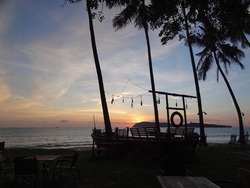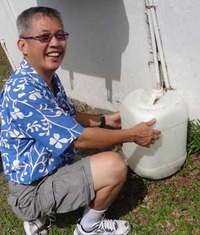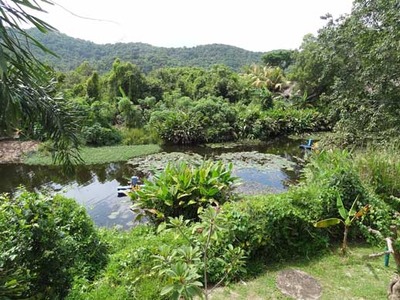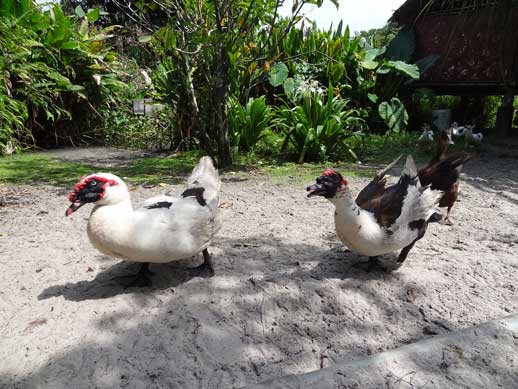Beyond green, this eco-resort in West Malaysia shows how organic methods can be applied to address environmental problems and tourism impacts to produce amazing results. Mallika Naguran meets the man behind this award-winning resort to learn of his unwavering commitment towards Mother Nature.
Langkawi, 18 October 2011. Frangipani Resort & Spa on Langkawi Island is a model showcase of how a hotel or resort can go green simply by putting a tall thinking hat on. One of its mantra is “Re-think” that goes with the other well-known principles – Reduce, Reuse and Recycle.

Anthony Wong explains how plants can prevent shore erosion
Thinking is part of the resort’s intrinsic culture. Managed by Anthony Wong, Frangipani Resort & Spa is every staff’s responsibility to improve its environmental worthiness, not just reduce negative impacts. Wong, who also owns and operates Asian Overland Tours, took over this 10 acres resort in 2005 and made a number of changes to it. The entire property was given a green sweep of life – from guestrooms, kitchen, bathrooms, pools, fixtures, and even the disused wetlands.
To describe every aspect of the environmental impressions of this resort would require a 10,000-word essay with photos and graphical illustrations, especially with the 150 different practices that have been carefully thought of and incorporated into the sustainable development and operations of Frangipani.
“We may go up to 200 by end of 2011,” says Wong of the number of initiatives in place, “but they have to be measured. If it cannot be measured, how can we consider it?”
Environmental sustainability officers are hired to keep track of these measurements to report back to the management, while ensuring that the resort maintains a high standard in comfort, safety and ecology.

A restored Tsunami boat sits pretty at Frangipani Langkawi Resort
“I’m working for the future, not just for the island but for tropical islands around the world. My wish is for people to build sustainable houses and hotels,” says Wong. Indeed, Wong is no ordinary hotelier. He leans on science as much as nature to research the best way to solve environmental problems, as we will soon learn. Staying at Frangipani Langkawi Resort & Spa is a true learning experience, and bookings can be made through Expedia.
Energy Savings
Before 2005, the resort had used four energy guzzling electric boilers for hot showers, and kitchen; incandescent lamps for light during day and night, big spotlights to enhance trees in the garden.
Now, energy saving lamps such as CFLs and LEDs are in place, a number of them with lampshades wrapped with aluminium foil for effects; with smaller spotlights used, the resort managed to reduce the wattage significantly, from 80W-250W per lamp before now to about 8W each. Lobby with tall glass doors and opened areas plus outdoor showers in guestrooms lowered energy consumption even further.
With the exception of solar powered heaters for hot showers in guestrooms and dish rinse in the kitchen, Frangipani Resort & Spa is still powered by the grid. But this may not be the case in the years to come as Wong plans to explore the use of solar panels and wind turbines to generate electricity. This could well set the resort on its journey towards becoming a carbon neutral resort, without having to purchase carbon offsets as others do.

Every drop is precious at Frangipani Langkawi Resort, even air-con drippings
The cost of solar panels for hot water in 2005 was RM400,000, which according to Wong, was well recovered within three years, not just by increasing room rates but by investing in cost cutting measures.
Average energy consumption per room fell with each passing year, from 61 kWh in 2006 to 38 kWh in August 2011 even with increased facilities. This resulted in savings of about RM16 per kWh in August 2011 for each guest room a year.
“Our gross operating profit is more than 60%, while most hotels make about 40-50%. We make more because we save on energy and water, due to our practices,” says Wong.
The resort is well on target to achieving RM11-12 million in sales revenue in 2011. In 2005, during its first year of operations, Frangipani Langkawi Resort & Spa made only around RM5-6 million.
As there are 150 fruit trees that give harvests of bananas and papayas, in addition to organically grown vegetables and herbs, the resort is able to run low food and beverage operations. Staff ratio is healthy, at 1.2 to a room.
More than 400 new trees has been planted to add to the previous 200 ones, to create biodiversity and “a cool microclimate.
Water Reuse

Pool decks at Frangipani Langkawi are washed with rainwater.
It seems that every drop of water is precious here. Rainwater is collected from gutter pipes on roofs, and at the resort entrance through a underwater storage device. This is then re-used for flushing toilets, watering the gardens and trees, and cleaning of floors and pool decks.
“Even with increased water use with the construction of gym, spa and an extra pool in the first three years, our water consumption fell by 40-45%,” says Wong.
The pool area is built on a 3 degree downward slope - a flood-proof tactic - which works well. Excess storm water is drained out to storage spaces, treated, then re-used. Even water droplets from air-con condensers are collected, explains Wong, as he re-adjusts a container to capture the maximum flow from the pipe, and briefly turns aside to instruct the sustainability manager to keep an eye on the containers so that they do not miss out on any single drop.
“We want to show others that green hotels, with some planning, need not be expensive,” says Wong.
Manmade Wetlands
What is most impressive about Frangipani Langkawi Resort & Spa, in my opinion, and which is why I travelled to this island from Singapore to witness first hand the incredible initiatives, is the treatment of black and grey water to a clear water pond through organic methods. A disused 0.6 acre pond that trapped rainwater triggered the imagination of Wong, thinking why not turn it into wetlands that would transform used water to purer conditions.

Aquatic plants treat black and grey water at this purpose-built wetlands
Hence an ingenuous use of botanical science to plant specific aquatic plants that do nature's job of cleaning, extracting, purifying – eradicating 99% of bacteria - and supplying nutrients. There are methodical stages for water treatment, as treated effluent from the sewer is mixed with grey water to flow from one group of water plants to another.

Ducks, chickens, geese, monitor lizards... these are part of the wetlands community
It starts with water mimosa (Neptunia spp) that reduces nitrogen and phosphorus values while absorbing organic compounds and suspended solids before flowing through to Thalia Geniculata, which further absorbs nutrients and stabilizes the suspended solids.
At the third stage, there is water hyacinth (Eichhornia crassipes). This, according to Wong, is very efficient in removing suspended materials, biochemical oxygen demand (BOD), nutrients, organic matter, heavy metals (lead, chrome and mercury etc.), and pathogens.
At the fourth and final point, the water is purified further with the presence of the following - duckweed, vetiver, water lily and water spinach - for these effects:
Duckweed (Lemna minor) to absorb nitrates, phosphate, potassium, calcium, sodium and carbon. Vetiver (Veteveria zizanioides) to filter sediment-bound contaminants (heavy metals and some pesticides residues). Water lily (Nymphaea) to remove cadmium and reduce algae growth in ponds. Finally, water spinach (Ipomoea aquatic Forsskal) to promote the growth of beneficial micro-organisms for nitrogen removal.

Treated water good enough to rear fish and feathered fowl, and even to drink.
No other resort, as far as I am aware, is this dedicated to the pursuit of knowledge through experimentation of science in the most organic manner. “I have been trying this for nearly five years now,” he enthuses, “and think I finally got it! ”Independent lab tests every six months reveal that the treated water quality is good enough to drink! But some may still squirm at tasting the water, not Wong, as he slurped a palm full of it in my presence.
No wonder the chickens, ducks and geese – about 120 of them - are plentiful and happy, multiplying freely around this lush aquatic habitat, and the fish reared in the pond is tasty! Birds abound as well, as many as 38 bird species that include 2 hornbill species, I am told.
“My vision is to be the greenest hotel in the world. And to be a research hub,” says Wong, as we later tucked into an appetizer course of crispy water spinach harvested from the resort's wetlands. Many students and environmentalists visit the resort to study its ways but Wong intends to share his experiments in a structured and meaningful way. He intends to build a dorm for student researches to be able to conduct their studies as long as possible, and at low cost.
Re-use and Recycle

Guests learn how waste is unused resource here
“The kitchen is the most polluting place in a hotel,” says Wong, as he leads us through the normally out-of-bounds busy area. Seven colour-coded bins in the kitchen help staff put waste away in an organised fashion for re-use and recycling.
Nearly nothing goes to waste at this eco-resort, especially organic waste: leftover food is fed to the animals, while egg shells and food bits strained from kitchen sinks are sent for composting at a dedicated compost center of the resort. Used cooking oil is used as candlelight fuel, and in the making of soaps. Fish gills and chicken entrails are ground to bits then buried three feet under in the garden to create humus.
“We have reduced 50% of waste this way,” says Wong, who rewards staff with a 2 to 4 month bonus for their efforts in energy and water conservation.

Seven bins to re-use & recycle waste in the kitchen
Ecological and environmental practices aside, this resort is comfortable and safe, run by warm and friendly staff. There are quiet spots and scenic scenes as well, such as the rooftop garden spaces, and beachfront. A boat rescued from total destruction during the Asian Tsunami sits prominently at the beachfront, serving as a romantic spot for cocktails at sunset.
“This is the way to show the future,” muses Wong. I couldn’t agree more.
Photos by Mallika Naguran
Frangipani Langkawi Resort & Spa is organising a music festival to promote environmental awareness at its premises. Calling music lovers and tree huggers - head on down to Langkawi island, West Malaysia for some great grooves. The inaugural One Earth Music Festival takes place over two evenings, from Friday 11 November to Saturday 12 November 2011.
Inspired by this resort, Mallika Naguran has started the Miracle Tree project. Read her blog here. Send in your photos, letters or thoughts about your favourite tree to be included in the Miracle Tree book.
Frangipani Langkawi Resort & Spa has won numerous awards including the most recent Anugerah Langkawi 2011 award in conjunction with Malaysia Environment Week.